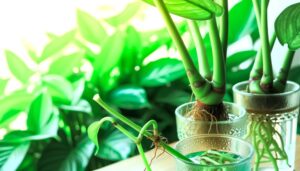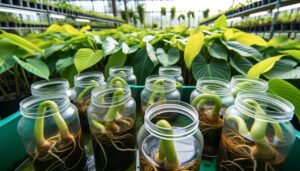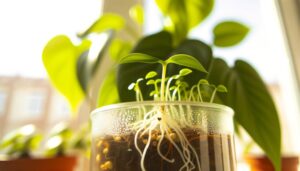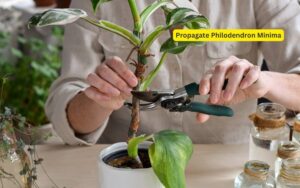Philodendron White Measure Propagation
Philodendron 'White Measure' propagation demands technical precision. Start with sterilized pruning shears and healthy cuttings that include at least one node.
Ensure each cut is made at a 45-degree angle. Rooting can be achieved either in dechlorinated water, with meticulous monitoring of temperature and humidity, or in a well-draining soil medium.
Regularly change the water or keep the soil appropriately moist, respectively. Proper humidity, indirect light, and sterile conditions are essential for root initiation and plant health.
After root establishment, transfer to pots with good drainage. Maintaining ideal care and troubleshooting common issues is crucial for successful propagation.
Learn the specific steps and details to master this process.
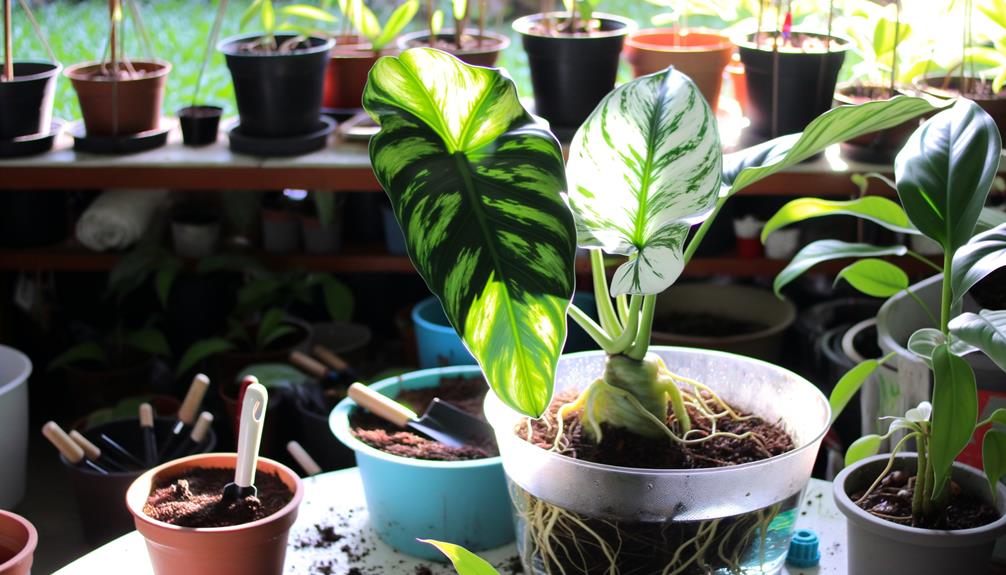
Key Takeaways
- Choose healthy cuttings with at least one node from disease-free Philodendron White Measure plants.
- Use sterile pruning shears or razor blades to make a 45-degree angled cut.
- Apply rooting hormone with indole-3-butyric acid to the cut end for better root initiation.
- Root cuttings in well-draining soil or dechlorinated water in indirect light, maintaining humidity.
- Monitor root development and transplant to suitable pots with proper drainage when roots are established.
Choosing the Right Tools
Selecting the appropriate tools for propagating Philodendron White Measure is essential to secure the best possible success and plant health. High-quality, sterile pruning shears are paramount for making precise cuts, minimizing tissue damage, and preventing pathogen transmission. A clean, sharp razor blade can also be used for delicate incisions.
Employing a rooting hormone, preferably containing indole-3-butyric acid (IBA), can enhance root initiation. Additionally, using sterilized pots and a well-draining propagation medium, such as a perlite-peat moss mix, ensures optimal aeration and moisture retention.
Sterilization of tools with isopropyl alcohol or a bleach solution is necessary to avert microbial contamination. Properly selected and maintained tools significantly impact the propagation process, promoting robust growth and reducing the risk of disease.
Selecting Healthy Cuttings
To guarantee successful spread of Philodendron White Measure, identifying and choosing cuttings from strong, disease-free parent plants is essential. Select cuttings from plants exhibiting robust growth, vibrant coloration, and no signs of pest infestation or disease.
Ideal cuttings should include at least one node, the segment where leaves and roots will emerge, and be approximately 4-6 inches long. Make sure the parent plant has mature, healthy leaves and a well-established root system. Avoid cuttings from plants showing yellowing, wilting, or mechanical damage, as these may harbor pathogens or lack vigor.
Preparing the Cuttings
To guarantee successful propagation of Philodendron White Measure, it is essential to choose healthy stems exhibiting robust growth and no signs of disease.
Sterilizing cutting tools with isopropyl alcohol or a bleach solution lessens the risk of pathogen transmission.
Additionally, making cuts at a 45-degree angle enhances the surface area for root development and optimizes water absorption.
Choosing Healthy Stems
A critical step in successful propagation of Philodendron White Measure involves identifying stems that exhibit robust health and vigor, characterized by vivid coloration and absence of disease or pest infestation. Healthy stems should display strong texture and consistent coloration, devoid of any brown spots or wilting signs. Selecting stems with at least one or two nodes ensures prime growth potential, as nodes are crucial for root development. A systematic analysis of stem characteristics can be summarized as follows:
| Stem Characteristics | Ideal Condition | Unfavorable Signs |
|---|---|---|
| Color | Vivid green or white | Yellowing, browning |
| Texture | Strong and turgid | Soft, mushy |
| Nodes | Present (1-2 minimum) | Absent |
| Pest/Disease Signs | None | Visible pests/infections |
This thorough selection process is foundational for effective propagation.
Sterilizing Cutting Tools
Sterilizing cutting tools is an essential procedure to prevent the transmission of pathogens and guarantee the health of Philodendron White Measure cuttings. To achieve this, employ a sterilization protocol involving either chemical agents or heat.
Common methods include submerging tools in a solution of 70% isopropyl alcohol for 5-10 minutes or using a 10% bleach solution for 20 minutes, followed by thorough rinsing with distilled water. Alternatively, tools can be sterilized by exposing them to an open flame for a few seconds.
Proper sterilization minimizes the risk of bacterial, viral, or fungal infections, ensuring that cuttings remain viable and can successfully develop into healthy plants. Regular tool maintenance is critical for best propagation outcomes.
Optimal Cutting Angle
Understanding the best cutting angle is vital for promoting the successful rooting and subsequent growth of Philodendron White Measure cuttings. A cut at a 45-degree angle is scientifically ideal, as it maximizes the surface area for root development and enhances nutrient uptake. This angle also reduces the risk of water pooling on the cut surface, which can lead to rot.
Precision in the cut is crucial; a clean, angled incision minimizes tissue damage and encourages healthy callus formation. Additionally, ensuring that the cutting tool is sharp and sterilized further aids in preventing pathogenic infections. By adhering to these guidelines, horticulturists can greatly improve the likelihood of successful propagation and robust plant growth.
Rooting in Water
Initiating propagation by rooting Philodendron White Measure cuttings in water involves precise control of environmental conditions to ensure successful root development. The cuttings should be placed in a see-through container filled with dechlorinated water, ensuring the nodes are fully submerged.
Best temperature ranges between 20-25°C, while humidity levels should be maintained at 60-70%. Indirect light is essential, preventing photoinhibition while promoting photosynthesis.
Regular water changes, ideally every 2-3 days, prevent microbial buildup that could impede root growth. Observing for root initiation, typically occurring within 2-4 weeks, is vital. The formation of healthy, white roots indicates readiness for transplantation.
Vigilant monitoring of water clarity and cleanliness cannot be overstated to foster a conducive rooting environment.
Rooting in Soil
For successful establishment in soil, it is important to select a well-draining potting mix composed of perlite, peat moss, and orchid bark to provide ideal aeration and moisture retention. This combination guarantees an ideal balance between water retention and drainage, essential for preventing root rot.
Insert the cutting into the soil at a depth of approximately 2-3 inches, making sure that at least one node is buried to encourage root development. Maintain consistent soil moisture by watering when the top inch becomes dry. Use a container with drainage holes to avoid waterlogging.
Monitoring for root emergence, which typically occurs within 4-6 weeks, is vital to assess propagation success. Employing this method promotes strong root systems and healthy plant growth.
Creating the Ideal Environment
For successful propagation of Philodendron White Measure, it is essential to establish ideal light conditions and maintain proper humidity levels.
The plant requires indirect, bright light to facilitate photosynthesis without causing leaf burn, while humidity levels between 60-70% are ideal for preventing desiccation and promoting root development.
These environmental parameters are critical for ensuring robust growth and minimizing stress during the propagation process.
Optimal Light Conditions
Ensuring the proper light conditions is essential for the successful propagation of Philodendron White Measure, as inadequate lighting can impede growth and overall plant health. Optimal light conditions involve bright, indirect sunlight, which mimics the diffused light found under a forest canopy. Direct sunlight, however, can cause leaf burn and photodamage. Utilizing grow lights can help maintain consistent light exposure, especially in low-light environments. The table below outlines the recommended light conditions:
| Light Condition | Description |
|---|---|
| Bright, Indirect | 10,000-20,000 lux |
| Direct Sunlight | Avoid |
| Grow Light Spectrum | Full-spectrum (400-700 nm) |
| Duration | 12-14 hours per day |
Proper Humidity Levels
Maintaining proper humidity levels is necessary for the successful propagation of Philodendron White Measure, as these plants thrive in environments with relative humidity ranging from 60% to 80%.
High humidity facilitates ideal gas exchange and prevents desiccation of the cutting, thereby promoting effective root formation. Utilizing a hygrometer can provide accurate measurements, ensuring the environment remains within the desired range.
Employing methods such as misting, using a humidity tray, or incorporating a humidifier can help maintain these conditions. Additionally, enclosing the propagating cuttings in a plastic bag or propagation tent can create a microenvironment with stable humidity levels.
However, it is important to monitor for excess moisture, which can lead to fungal infections and negatively impact propagation success.
Watering and Care
Proper watering and care practices are crucial to the successful propagation and growth of Philodendron White Measure. Consistent hydration is essential, yet over-watering must be avoided due to the plant's susceptibility to root rot. Utilize distilled or rainwater to prevent mineral build-up, and make sure the water is at room temperature.
Watering should be done when the top 1-2 inches of the soil are dry, maintaining a balance between moisture and aeration. Additionally, providing indirect, bright light optimizes photosynthesis without causing leaf burn. Relative humidity levels should be sustained at 60-80%, using a humidifier if necessary.
Regularly inspect for pests and disease, applying appropriate treatments promptly. These careful care protocols ensure robust growth and health.
Transferring to Pots
Transferring Philodendron White Measure cuttings to pots demands careful attention to soil composition, container size, and environmental conditions to promote best root development and overall plant health.
The ideal potting mix should be well-draining yet moisture-retentive, typically a blend of peat, perlite, and orchid bark. Selecting an appropriately sized container is vital; a pot with a diameter of 4-6 inches is generally recommended for young cuttings. Confirm the presence of drainage holes to prevent waterlogging, which can lead to root rot.
Maintain ambient temperatures between 70-80°F and provide indirect, bright light. Additionally, high humidity levels (60-70%) are beneficial. Properly acclimatizing cuttings to these conditions is necessary to ensure robust root establishment and vigorous growth.
Monitoring Growth
Careful monitoring of Philodendron White Measure growth involves regular assessment of leaf development, stem strength, and root health to guarantee plant vitality.
Leaf development should be characterized by consistent emergence of new leaves with uniform variegation patterns and absence of chlorosis or necrosis.
Stem strength can be evaluated by examining the firmness and upright growth of the stems, indicative of robust cellular structure and nutrient distribution.
Root health is essential; roots should be white, firm, and free from rot or pathogen presence. Monitoring soil moisture levels and ensuring adequate aeration are pivotal in promoting best root conditions.
Regular inspections, coupled with meticulous documentation, facilitate early detection of deviations, thereby enabling timely corrective measures to sustain healthy growth dynamics.
Troubleshooting Common Issues
Identifying and addressing common issues in Philodendron White Measure propagation requires a systematic approach to diagnose symptoms such as leaf discoloration, pest infestation, and abnormal growth patterns. A thorough examination is essential to isolate the root cause and implement effective remedial methods.
Key issues include:
- Leaf Discoloration: Typically caused by nutrient deficiencies or improper watering. Maintain balanced fertilization and consistent moisture levels.
- Pest Infestation: Common pests include spider mites and aphids. Regularly inspect and treat with suitable insecticides.
- Root Rot: Often a result of waterlogged soil. Improve drainage and avoid overwatering.
- Abnormal Growth Patterns: Indicative of insufficient light or extreme temperature variations. Adjust environmental conditions accordingly.
A methodical approach secures successful propagation and robust plant health.
Conclusion
Proper propagation of Philodendron White Measure plants requires meticulous methods, ensuring success through strategic steps.
Selecting superior specimens, preparing precise cuttings, and rooting rigorously in water or soil are pivotal procedures.
Watering with wisdom and carefully transferring to pots are essential for thriving transplants.
By monitoring meticulously and troubleshooting tenaciously, ideal outcomes in propagation are achievable.
Through a combination of scientific scrutiny and technical techniques, the Philodendron White Measure plant can flourish, fostering future flora.

